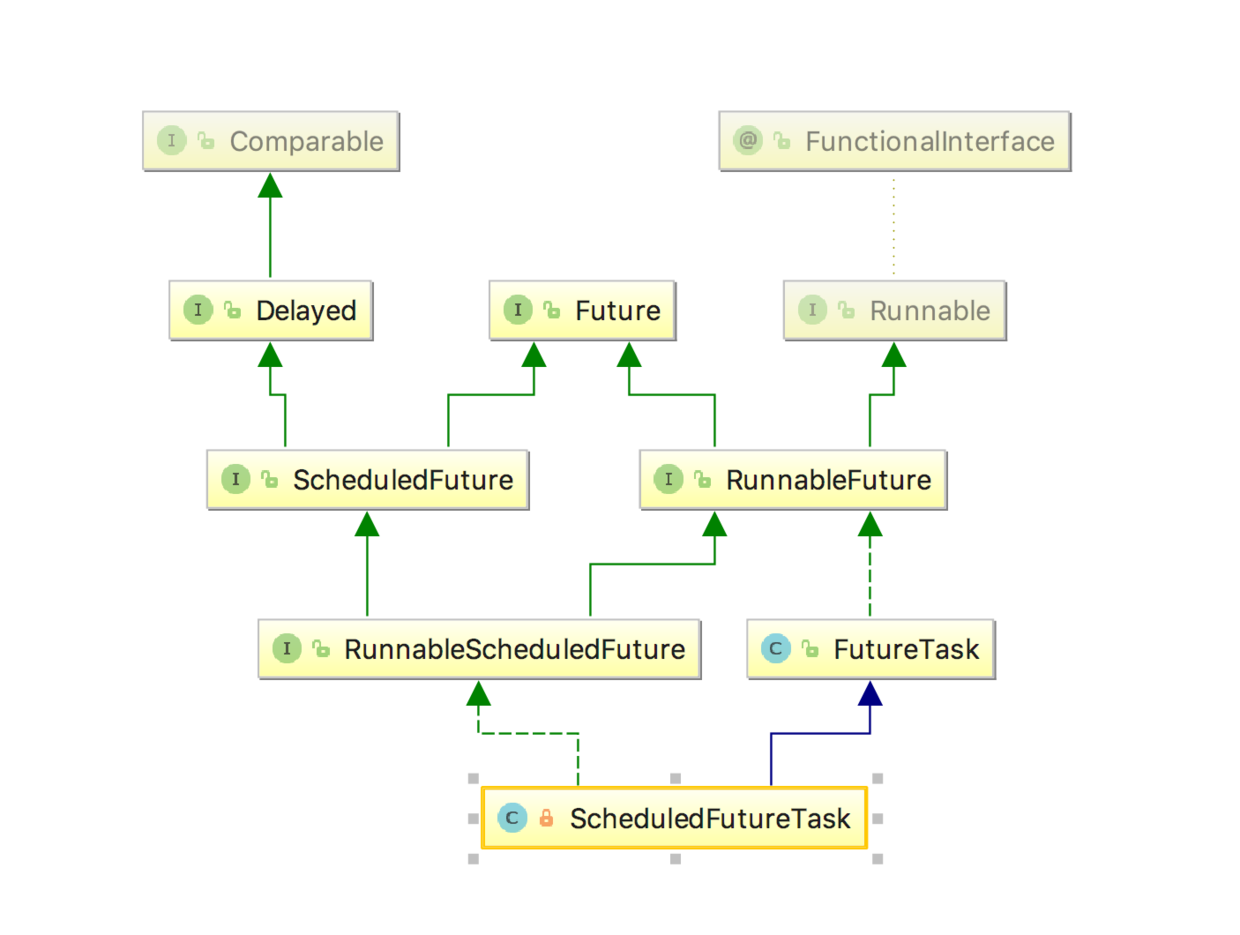ScheduledThreadPoolExecutor解析
ScheduledThreadPoolExecutor适用于延时执行,或者周期性执行的任务调度,ScheduledThreadPoolExecutor在实现上继承了ThreadPoolExecutor,所以依然可以将ScheduledThreadPoolExecutor当成ThreadPoolExecutor来使用,但是ScheduledThreadPoolExecutor的功能要强大得多,因为ScheduledThreadPoolExecutor可以根据设定的参数来周期性调度运行,下面是四个和周期性相关的方法:
1.scheduled()
public class ScheduledThreadPoolExecutor extends ThreadPoolExecutor implements ScheduledExecutorService { public ScheduledFuture<?> schedule(Runnable command, long delay, TimeUnit unit) { if (command == null || unit == null) throw new NullPointerException(); RunnableScheduledFuture<?> t = decorateTask(command, new ScheduledFutureTask<Void>(command, null, triggerTime(delay, unit))); delayedExecute(t); return t; } public <V> ScheduledFuture<V> schedule(Callable<V> callable, long delay, TimeUnit unit) { if (callable == null || unit == null) throw new NullPointerException(); RunnableScheduledFuture<V> t = decorateTask(callable, new ScheduledFutureTask<V>(callable, triggerTime(delay, unit))); delayedExecute(t); return t; } }
2.scheduleAtFixedRate()
public ScheduledFuture<?> scheduleAtFixedRate(Runnable command, long initialDelay, long period, TimeUnit unit) if (command == null || unit == null) throw new NullPointerException(); if (period <= 0) throw new IllegalArgumentException(); ScheduledFutureTask<Void> sft = new ScheduledFutureTask<Void>(command, null, triggerTime(initialDelay, unit), unit.toNanos(period)); RunnableScheduledFuture<Void> t = decorateTask(command, sft); sft.outerTask = t; delayedExecute(t); return t; }
说明: 该方法会延时一段时间,然后根据设定的参数周期执行Runnable,在执行时将严格按照规划的时间路径来执行,比如周期为2,延时为0,那么执行的序列为0,2,4,6,8....,
3.scheduleWithFixedDelay()
public ScheduledFuture<?> scheduleWithFixedDelay(Runnable command, long initialDelay, long delay, TimeUnit unit){ if (command == null || unit == null) throw new NullPointerException(); if (delay <= 0) throw new IllegalArgumentException();
//保证了任务的延时执行 或周期执行 ScheduledFutureTask<Void> sft = new ScheduledFutureTask<Void>(command, null, triggerTime(initialDelay, unit), unit.toNanos(-delay)); RunnableScheduledFuture<Void> t = decorateTask(command, sft); sft.outerTask = t; delayedExecute(t); return t; }
说明:该方法会延时一段时间,然后根据设定的参数周期执行Runnable,在执行时将基于上次执行时间来规划下次的执行,也就是在上次执行完成之后再次执行。比如上面的执行序列0,2,4,6,8...,如果第2秒没有被调度执行,而在第三秒的时候才被调度,那么下次执行的时间不是4,而是5,以此类推。
通过上面的代码我们可以发现,前两个方法是类似的,后两个方法也是类似的。前两个方法属于一次性调度,所以period都为0,区别在于参数不同,一个是Runnable,而一个是Callable,它们最后都变为了Callable了,以上四个方法最后都会调用一个方法: delayedExecute(t),下面看一下这个方法:
4.delayedExecute()
private void delayedExecute(RunnableScheduledFuture<?> task) { if (isShutdown()) reject(task); else { super.getQueue().add(task); if (isShutdown() && !canRunInCurrentRunState(task.isPeriodic()) && remove(task)) task.cancel(false); else ensurePrestart(); } }
说明:该方法先判断线程池是否被关闭了,如果被关闭了,则拒绝任务的提交,否则将任务加入到任务队列中去等待被调度执行。最后的ensurePrestart的意思是需要确保线程池已经被启动起来了。下面是这个方法:
5.ensurePrestart()
void ensurePrestart() { int wc = workerCountOf(ctl.get()); if (wc < corePoolSize) addWorker(null, true); else if (wc == 0) addWorker(null, false); }
说明:该方法主要是增加了一个没有任务的worker,有什么用呢?我们还记得Worker的逻辑吗?addWorker方法的执行,会触发Worker的run方法的执行,然后runWorker方法就会被执行,而runWorker方法是循环从workQueue中取任务执行的,所以确保线程池被启动起来是重要的,而只需要简单的执行addWorker便会触发线程池的启动流程。对于调度线程池来说,只要执行了addWorker方法,那么线程池就会一直在后台周期性的调度执行任务。
6. ScheduledFutureTask.java
ScheduledFutureTask类图

ScheduledFutureTask是ScheduledThreadPoolExecutor的内部类,它实现了Runnable接口,并重写run方法,而这个run方法是整个类的核心,下面来看一下这个run方法的内容:
public void run() { boolean periodic = isPeriodic(); if (!canRunInCurrentRunState(periodic)) cancel(false); else if (!periodic) ScheduledFutureTask.super.run(); else if (ScheduledFutureTask.super.runAndReset()) { setNextRunTime(); reExecutePeriodic(outerTask); } } } private void setNextRunTime() { long p = period; if (p > 0) time += p; else time = triggerTime(-p); }
说明:该方法首先判断是否是周期性的任务,如果不是,则直接执行(一次性),否则执行,然后设置下次执行的时间,然后重新调度,等待下次执行。这里有一个方法需要注意,也就是setNextRunTime,上面我们提到scheduleAtFixedRate和scheduleWithFixedDelay在传递参数时不一样,后者将delay值变为了负数,所以此处的处理正好印证了前文所述。
7.reExecutePeriodic方法
reExecutePeriodic方法会将任务再次被调度执行,下面的代码展示了这个功能的实现:
RunnableScheduledFuture<V> outerTask = this; void reExecutePeriodic(RunnableScheduledFuture<?> task) { if (canRunInCurrentRunState(true)) { super.getQueue().add(task); if (!canRunInCurrentRunState(true) && remove(task)) task.cancel(false); else ensurePrestart(); } }
说明:可以看到,这个方法就是将我们的任务再次放到了workQueue里面,那这个参数是什么?在上面的run方法中我们调用了reExecutePeriodic方法,参数为outerTask,而这个变量是什么?这个变量指向了自己,而this的类型是什么?是ScheduledFutureTask,也就是可以被调度的task,这样就实现了循环执行任务了。
8.ScheduledThreadPoolExecutor
上面的分析已经到了循环执行,但是ScheduledThreadPoolExecutor的功能是周期性执行,所以我们接着分析ScheduledThreadPoolExecutor是如何根据我们的参数走走停停的。这个时候,是应该看一下ScheduledThreadPoolExecutor的构造函数了,我们来看一个最简单的构造函数:
public ScheduledThreadPoolExecutor(int corePoolSize) {
super(corePoolSize, Integer.MAX_VALUE, 0, NANOSECONDS, new DelayedWorkQueue());
}
9.DelayedWorkQueue
DelayedWorkQueue是ScheduledThreadPoolExecutor的内部类,
1. take()方法代码如下
public RunnableScheduledFuture<?> take() throws InterruptedException { final ReentrantLock lock = this.lock; lock.lockInterruptibly(); try { for (;;) { RunnableScheduledFuture<?> first = queue[0]; if (first == null) available.await(); else { long delay = first.getDelay(NANOSECONDS); if (delay <= 0) return finishPoll(first); first = null; // don't retain ref while waiting if (leader != null) available.await(); else { Thread thisThread = Thread.currentThread(); leader = thisThread; try { available.awaitNanos(delay); } finally { if (leader == thisThread) leader = null; } } } } } finally { if (leader == null && queue[0] != null) available.signal(); lock.unlock(); } }
在for循环里面,首先从queue中获取第一个任务,然后从任务中取出延迟时间,而后使用available变量来实现延迟效果。
private final Condition available = lock.newCondition();
queue队列它是一个RunnableScheduledFuture类型的数组
private RunnableScheduledFuture<?>[] queue = new RunnableScheduledFuture<?>[INITIAL_CAPACITY];
2.add()方法
public boolean add(Runnable e) { return offer(e); } public boolean offer(Runnable x) { if (x == null) throw new NullPointerException(); RunnableScheduledFuture<?> e = (RunnableScheduledFuture<?>)x; final ReentrantLock lock = this.lock; lock.lock(); try { int i = size; if (i >= queue.length) grow(); size = i + 1; if (i == 0) { queue[0] = e; setIndex(e, 0); } else { siftUp(i, e); } if (queue[0] == e) { leader = null; available.signal(); } } finally { lock.unlock(); } return true; }
说明:add方法直接转到了offer方法,该方法中,首先判断数组的容量是否足够,如果不够则grow,增长的策略如下:
int newCapacity = oldCapacity + (oldCapacity >> 1); // grow 50%
每次增长50%,入戏下去。增长完成后,如果这是第一个元素,则放在坐标为0的位置,否则,使用siftUp操作,下面是该方法的内容:
3.siftUp()
private void siftUp(int k, RunnableScheduledFuture<?> key) { while (k > 0) { int parent = (k - 1) >>> 1; RunnableScheduledFuture<?> e = queue[parent]; if (key.compareTo(e) >= 0) break; queue[k] = e; setIndex(e, k); k = parent; } queue[k] = key; setIndex(key, k); }
这个数组实现了堆这种数据结构,使用对象比较将最需要被调度执行的RunnableScheduledFuture放到数组的前面,而这得力于compareTo方法,下面是RunnableScheduledFuture类的compareTo方法的实现,主要是通过延迟时间来做比较。
RunnableScheduledFuture.compareTo()
public int compareTo(Delayed other) { if (other == this) // compare zero if same object return 0; if (other instanceof ScheduledFutureTask) { ScheduledFutureTask<?> x = (ScheduledFutureTask<?>)other; long diff = time - x.time; if (diff < 0) return -1; else if (diff > 0) return 1; else if (sequenceNumber < x.sequenceNumber) return -1; else return 1; } long diff = getDelay(NANOSECONDS) - other.getDelay(NANOSECONDS); return (diff < 0) ? -1 : (diff > 0) ? 1 : 0; }
上面是生产元素,下面来看一下消费数据。在上面我们提到的take方法中,使用了一个方法如下:
private RunnableScheduledFuture<?> finishPoll(RunnableScheduledFuture<?> f) { int s = --size; RunnableScheduledFuture<?> x = queue[s]; queue[s] = null; if (s != 0) siftDown(0, x); setIndex(f, -1); return f; }
这个方法中调用了一个方法siftDown,这个方法如下:
private void siftDown(int k, RunnableScheduledFuture<?> key) { int half = size >>> 1; while (k < half) { int child = (k << 1) + 1; RunnableScheduledFuture<?> c = queue[child]; int right = child + 1; if (right < size && c.compareTo(queue[right]) > 0) c = queue[child = right]; if (key.compareTo(c) <= 0) break; queue[k] = c; setIndex(c, k); k = child; } queue[k] = key; setIndex(key, k); }
Replaces first element with last and sifts it down. Call only when holding lock.在上面的take方法里面,首先获取了delay,然后再使用available来做延迟效果,其中delay是通过RunnableScheduledFuture类的getDelay方法获取,RunnableScheduledFuture类实现了Delayed接口,而Delayed接口里面的唯一方法是getDelay,我们到RunnableScheduledFuture里面看一下这个方法的具体实现:
public long getDelay(TimeUnit unit) { return unit.convert(time - now(), NANOSECONDS); }
time是我们设定的下次执行的时间,所以延迟就是(time - now()),
到此为止,我们梳理了ScheduledThreadPoolExecutor是如何实现周期性调度的,首先分析了它的循环性,然后分析了它的延迟效果。